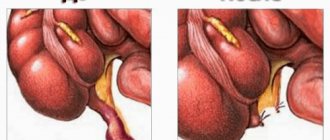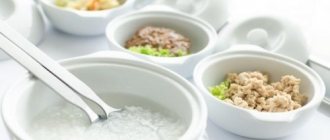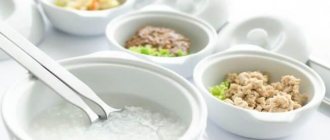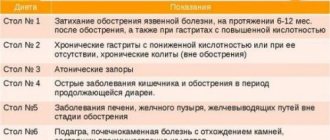Causes of constipation after surgery
- Depressant effect of anesthesia.
As a result of the effect of muscle relaxant drugs on the human body, all muscles, including the muscular layer of the intestinal wall, relax; they need some time to regain their tone. That is why atonic constipation occurs so often in the postoperative period. - Taking painkillers.
Some drugs, especially opioid analgesics, can inhibit the gastrointestinal tract.
- Disruption of digestive processes.
This problem occurs after operations on the stomach, intestines, removal of the gallbladder, etc. The body needs time to rebuild the digestive processes and normalize the production of the necessary enzymes. - Dysbacteriosis.
During the rehabilitation period, doctors often prescribe antibiotics to prevent postoperative complications. As a side effect of taking such drugs, it is possible to disrupt the balance of beneficial intestinal microflora. - Long-term bed rest.
Lack of physical activity for several days leads to a decrease in the tone of the abdominal muscles, which are also involved in the movement of feces. As a result, constipation occurs. - Changing your diet.
Postoperative diet may also cause constipation. - Psychological reasons.
After surgery, many patients worry about the condition of the stitches or are afraid of pain when straining (especially if hemorrhoids were previously diagnosed), so they put off going to the toilet, which provokes constipation.
Up to contents
Basic nutrition rules
Proper nutrition will help tissue heal quickly.
To ensure the fastest possible healing of tissues, it is necessary to adhere to certain rules:
- The first day after surgery, eating food is strictly prohibited.
- The patient is advised to adhere to a strict diet for three weeks.
- Doctors do not allow you to eat fatty, spicy and fried foods, as well as smoked foods.
- Food should be prepared by boiling, stewing, or baking. You can also steam food.
- Eating rough food is strictly prohibited. That is why it is pre-crushed.
- The patient's diet must necessarily consist of fermented milk products.
- Doctors do not allow the consumption of sweets during the postoperative period.
- The patient must also avoid alcoholic and carbonated drinks.
- Sour fruits and berries are prohibited for the patient after surgery.
- In order to stimulate the intestines, you need to drink coffee. But, the patient is recommended to consult a doctor first.
- Meals should be taken at the same time, which will promote complete intestinal motility.
- Avoid eating foods that cause bloating. This is why patients need to give up nuts, citrus fruits, tomatoes, mushrooms, etc.
- Meals should be fractional. The patient should eat often, but at the same time he should be given minimal portions of food.
If a person adheres to all of the above rules, this will have a positive impact on the success of the recovery period.
Constipation symptoms
The inability to defecate for several days is the main sign of constipation. In this case, the patient usually feels heaviness in the abdomen. He may be bothered by nagging pain. Flatulence often appears, since gases also do not pass away, and negative processes with stagnation of feces, on the contrary, intensify. Intoxication of the body gradually develops. The patient may experience nausea. His appetite worsens, sleep is disturbed, and his mood decreases. Hardened stool can injure the mucous membrane and even provoke minor bleeding. Therefore, during the act of defecation, mucus and blood can be found in the stool.
Up to contents
Therapeutic diet is the key to normal bowel function
In order not to overload the intestines, you should not eat on the first day after surgery. On the second or third days, the patient is allowed to eat broths and liquid fermented milk products. After a few more days, the diet includes porridge with water, pumpkin puree, baked apples, and wheat crackers.
For a month after surgery, to normalize the intestinal flora, it is recommended to consume:
- fermented milk products - cottage cheese, yoghurts, fermented baked milk, kefir;
- rabbit, chicken, turkey meat;
- semolina, rice, pearl barley, oatmeal, barley porridge;
- carrots and beets;
- apples, plums, apricots.
You need to eat fractionally at regular intervals, the serving size should not exceed 200 g. It is important to maintain a drinking regime and drink at least 2 liters of liquid daily.
General treatment regimen for postoperative constipation
Sometimes constipation goes away on its own, but in most cases it requires taking certain measures, especially after surgery, when the risk of complications is especially high. If problems with bowel movements continue for several days, and other unpleasant symptoms appear, you should consult a doctor as soon as possible. He will help identify the cause and decide what to do to eliminate constipation. There are several methods to combat it. Many of them can be combined to achieve better results.
- Drug therapy .
Only a doctor can prescribe it. When choosing drugs, the type of surgical intervention performed, the patient’s condition and the medications already used must be taken into account.
- Compliance with diet and drinking regime .
Patients need to drink 1.5–2 liters of fluid per day. If it is water, then it must be purified and without gas. Meals in the postoperative period are only fractional, in small portions 5–6 times a day. The diet depends on the type of surgery. But in any case, you need to avoid foods that provoke gas formation (legumes, cabbage, radishes, eggplants) or have an astringent effect (pears, rice, semolina, fatty fish or meat broths). For constipation, it is better to give preference to dishes containing fiber, natural juices, whole grain porridges, bran bread and fermented milk products, unless a different diet has been prescribed by your doctor.
- Gymnastics or feasible physical activity
. Each patient after surgery should begin to move as quickly as possible (if there are no contraindications). Prolonged bed rest provokes constipation. If you can’t do gymnastics, it is advisable to at least start turning over in bed and walking, gradually increasing the walking time. The set of exercises must be agreed upon with your doctor, since such physical activity is contraindicated during some operations.
- Taking pre- and probiotics.
They are necessary to normalize the composition of beneficial microflora in the intestines.
- Hardware or manual abdominal massage.
Can be prescribed by a doctor in the absence of contraindications. It is performed in a lying position, when the abdominal muscles are as relaxed as possible. One session lasts about 10 minutes.
Up to contents
Recommendations for patients after colon surgery
Recommendations for patients undergoing colon or rectal surgery
- Visit your healthcare provider regularly. Control examinations are recommended after a month, 3 months, 6 months, for the first 2 years – once every 6 months, then – once a year.
- Shared toilet: shared shower is recommended (avoid baths, saunas)
- Wash the stoma (reduced intestine) with soap and water, then do not wipe it, but blot it with a soft cloth or gauze (do not use cotton wool)
- After using the toilet, treat the stoma (reduced intestine) with baby cream.
- If the skin around the stoma (reduced intestine) is irritated, treat with Lassara paste (salicylic-zinc paste), baby powder or products from Coloplast, Convatec (information by phone 324-10-55 )
- If there is bleeding from the stoma (lowered intestine), apply a dry cloth and press firmly for 10-15 minutes.
- After the “reduction” operation, it is recommended to carry out high cleansing enemas every 2-3 days for the purpose of mechanical cleansing of the intestines.
- In case of cramping abdominal pain, stool and gas retention, nausea, vomiting, bloating, use:
- 2-3 tablets of No-spa at a time
- stop eating, don't drink water
- cold on the stomach (any product from the freezer compartment of the refrigerator)
- if relief does not occur after 2-3 hours, consult your doctor, if not possible, call “03”
What is a stoma?
In order to understand what changes and problems ostomy patients face after having a stoma, let's start with a brief description of the gastrointestinal tract.
From the stomach, food enters the small intestine (about 7-10 m long), consisting of the duodenum, jejunum and ileum. The latter is called ileum in Latin. In the small intestine, the process of chemical processing of food under the influence of digestive juices and enzymes and the absorption of nutrients into the blood are completed. The contents of the small intestine are liquid. Next, products that the body does not need enter the large intestine, where, as they pass through it, they acquire the consistency of dense feces. The large intestine (length about 1.5 m, diameter about 5 cm) consists of the cecum, ascending colon, transverse colon, descending colon, sigmoid colon, rectum.
Thus, the large intestine plays a small role in digesting food, therefore, if surgical intervention is necessary (disease, intestinal injury), the surgeon can form an artificial anus on the abdominal wall, i.e. to impose a stoma (from the Greek stoma means mouth).
Depending on the section of intestine that is removed, the operation is called a colostomy or ileostomy. In a number of diseases of the genitourinary system (bladder cancer, bladder stenosis, trauma), the surgeon places a urostomy.
An ileostomy is placed on the right side of the abdominal wall, at the border of the small and large intestines. The colostomy is located on the left side of the abdominal wall. The stoma may have a different location depending on what part of the intestine needs to be removed. There are three types of stoma depending on the surgical intervention: double-barrel (loop), single-barrel (end) and parietal. The stoma can have a convex, flat or retracted shape.
The colostomy is bright red in color. Its color is the same as the color of the oral mucosa. Most often, the stoma lags behind the edges of the abdominal skin. After surgery, the stoma may be swollen, but the swelling will subside over time. Its normal size is about 2-5 cm in diameter. Depending on the type of operation, the resulting stoma may have one or two openings that expand during stool passage. Due to the lack of innervation of the mucous membrane, touching the stoma during care is painless. A little bleeding during stoma care is also normal and should not cause you any fear. If the bleeding is prolonged and profuse, you should consult a doctor.
Stoma is not a disease
Thanks to modern stoma care products, a person is able to lead a normal active lifestyle, work, and love. Coloplast products have been used in the Oncoproctology Department of the Russian Cancer Research Center for the past few years. The main components that were popular were colostomy bags and various stoma care products (ointments, pastes, powders, plugs, cleansing wipes, etc.).
Despite the tendency in the clinic to perform sphincter- and organ-preserving operations, the percentage of operations ending in colostomy is about 25%. Of all the types of colostomy bags, our patients are most satisfied with two-component colostomy bags with open ostomy bags. This is primarily due to economic considerations - the ability to use ostomy bags several times. After all, the cost of colostomy bags does not allow their regular use by all patients. The most common sizes of colostomy bags are 45, 55, 60, 72 mm in diameter.
Ostomy bags are rarely needed for ileostomies. In our clinic we try to avoid their formation.
An important point is the presence of flavorings that eliminate unpleasant odors, which contributes to better adaptation of patients in society.
The most popular among patients are various creams and lotions for treating the skin around the colostomy. Colostomy plugs and “second skin” protective film are also interesting.
I would like to note that Coloplast products, despite their higher cost compared to some analogues, are distinguished by their simplicity and ease of use, aesthetics and durability of use, which allows patients to neutralize the painful sensations associated with the presence of a colostomy.
Practical recommendations for stoma care
After surgical placement of a stoma, it is impossible to control the emptying of intestinal contents, since there are no adductor muscles, such as in the anus. The contents of the intestines, as they form, are released through the stoma, regardless of your will: through the ileostomy - continuously 4-5 hours after eating, and its amount reaches 800-1500 ml; through a colostomy - the stool is usually semi-solid and formed. Normalization of the discharged contents from the stoma occurs in most cases after 6 months or earlier, after a few weeks. Therefore, it is necessary to constantly use stoma care products.
They are one- and two-component systems. The one-component system is self-adhesive ostomy bags. The two-component system consists of ostomy bags with an adhesive plate. Ostomy bags can be closed or open, with the contents discharged; transparent and opaque. The adhesive plate is equipped with a flange connection in the form of a ring. The ostomy bag is also equipped with a ring that seals with the flange connection of the adhesive plate. Open bags have clips. Ostomy bags are equipped with an odor-absorbing filter containing activated carbon. Ostobon powder to absorb odor .
Stoma care is simple:
Comfeel cleansers (hair is also removed). Then dry the skin with a soft towel using blotting movements.
The adhesive layer of the plate is protected by a paper layer. Remove the protective paper from the plate and warm it with your hands for easy adhesion.
Place the plate so that the hole in the plate fits exactly against the stoma, i.e. intestinal mouth. Starting at the bottom edge of the wafer, adhere the wafer to the skin, being careful not to create wrinkles in the adhesive wafer, which could cause the seal to fail.
The plate hole is also equipped with a paper stencil. Cut a hole along the marked contour in accordance with the diameter of the stoma. In this case, the size of the cut hole should be 3-4 mm larger than the size of the stoma. We recommend using scissors with curved ends.
The ostomy bag is then precisely pushed onto the ring of the plate until it “slams shut”. You will hear a click. The ring of the ostomy bag is equipped with lugs to which a belt can be attached for greater security.
A used bag emptied in the toilet should be thrown away. Closed bags are usually for one-time use, but open ones can be washed and used several times.
Ostomy patients change bags 1 or 2 times a day. To avoid rupture of the ostomy bag, do not allow it to overfill. The plate is changed when it begins to separate from the skin and does not fit tightly. This condition is determined by the whitish color of the adhesive plate.
To avoid skin injury, do not remove the ostomy bag by jerking or using mechanical means or chemical solvents. Removal occurs in the reverse order, starting from the top edge.
If there are irregularities around the stoma, they can be filled with special pastes produced.
There are also special adhesive rings and wipes that protect the skin around the stoma from irritation and contact with intestinal discharge.
So-called Conseal are used to close the stoma during bowel movements using lavage (irrigation), during water procedures, visiting a pool or sauna, and during sex.
Rehabilitation of ostomy patients
Immediately after surgery, ostomy patients find it difficult to come to terms with the idea of leading a normal daily life in a new environment with a formed stoma. Over time, habituation and adaptation gradually follows. To lead a normal life, you need to learn how to quickly and correctly care for your stoma and overcome the psychological barrier, which your loved ones will undoubtedly help you with. After some time, when you get used to daily emptying and changing bags, you will not think about it so much, and after rehabilitation and returning to work, you will even forget.
Who can you tell about your stoma? You should not talk about this unless absolutely necessary to your relatives and friends. Your close family members with whom you live should know about this.
You can wear normal clothes and the ostomy bag is not visible. You can dress the same as you did before your ostomy. You need to know that you can swim, take a shower, and the ostomy bags will not come off. If the stoma is in the waist area, it is recommended to wear suspenders instead of a belt.
After complete rehabilitation, you can and even should return to your job. However, this work should not be physically strenuous.
Sexual life is not subject to restrictions. Difficulties in this matter are usually psychological in nature. Over time, you will find that your sex life gives you as much joy and satisfaction as it did before the operation. Women also retain their reproductive function: they can become pregnant and give birth.
There is no special diet for ostomy patients. Most patients can eat and drink the same things they did before surgery. But some foods and drinks can cause gas accumulation. It is necessary to limit the consumption of eggs, cabbage, onions, asparagus, chocolate, beer and lemonade. The approach to nutrition is very individual: you decide what is possible and what should be avoided.
Your diet should be varied and rich in vitamins. You need to eat slowly and chew your food thoroughly. It is necessary to eat three times a day, with large meals in the morning. Dishes should not be very fatty and not very sweet; it is necessary to remember about large losses of water and electrolytes. Therefore, you should take 2 liters of fluid per day. Alcohol in small quantities is not contraindicated, with the exception of beer, which should be crossed off the menu. Bran, buttermilk, yogurt, lingonberry juice are recommended, which reduce the amount of gases and their unpleasant odor.
Having a stoma, you can engage in many sports without much physical exertion. You can travel without restrictions. Before your trip, take enough ostomy care products. You can swim in natural ponds and in the pool.
Visit theaters, cinema, exhibitions.
Helpful tips for stoma care
Coloplast ostomy bags do not allow gases to pass through. They are reliable and contain an activated carbon filter, which eliminates unpleasant odors.
The skin in the stoma area requires constant attention. Skin irritation can be caused by intestinal discharge, sweat, or insufficient care. Its manifestations vary in degree: redness, blisters, cracks, abscesses. The skin needs to be cleaned regularly. After washing, irritated skin should be covered with a special healing cream Comfeel . The bags need to be changed if the intestinal contents get slightly under the adhesive layer, which indicates a leak. In cases of skin irritation, it is better to use two-component systems. In these systems, only the ostomy bags are changed, while the adhesive plate remains on the skin for several days. The adhesive material not only sticks to the skin, but also has healing properties.
Diarrhea most often occurs due to a gastrointestinal infection or poor diet. In such cases, you should avoid spicy foods, vegetables and juices. Be sure to take more liquid.
Constipation can cause discomfort. Foods such as oranges, nuts, asparagus, and mushrooms take a very long time to digest and can lead to constipation. During this time, it is recommended to eat more fruits and vegetables, move more and do exercise. If constipation recurs, you should consult a doctor.
Irrigation is the controlled emptying of the bowel using lavage. In practice, intestinal lavage consists of introducing very slowly warm water into the stoma in an amount of 0.5 liters once a day or once every two days. You can only rinse the large intestine. Conseal or Mini Cap anal tampons instead of ostomy bags .
Sometimes ostomy patients have to deal with various complications, in addition to skin irritation, diarrhea, constipation: narrowing of the stoma, prolapse of the stoma, hernia in the area of the stoma. In all such cases, you must consult a doctor.
During your hospital stay after surgery, the staff will help you choose stoma care products and teach you how to use them.
There are societies for ostomy patients, whose activities are aimed at exchanging experiences, mutual advice, information about new devices, and solving family and employment problems. Ostomy patients in these societies do not feel so much loneliness and can talk openly and without false modesty about their problems.
List of recommended and non-recommended foods
First courses (soups)
Recommended: oat flakes (rolled oats); rice, semolina, meat broth with dumplings, noodles, meatballs, pancakes, rice; potato soup, vegetable soups (puree).
Not recommended: from legumes, from cabbage, from dried vegetables, from concentrates.
Meat
Recommended: beef, veal, lean pork, poultry, rabbit, lean ham, soft smoked meats, offal - liver, brains; language. The meat can be boiled, stewed, fried or sometimes fried.
Not recommended: goose, duck, game, offal, smoked meat, stew.
Sauces
Recommended: meat, dill, tomato, liver; A small amount of mayonnaise is allowed, preferably not natural.
Fish
Recommended: low-fat, boiled, baked; on a spit - trout, perch, fresh cod, flounder, canned fish in its own juice.
Not recommended: fatty fish, canned fish, in sauce or marinade; tuna, salmon, eel, mackerel, herring, sardines, anchovies; crustaceans.
Eggs
Recommended: soft-boiled, hard-boiled, fried eggs, omelet, biscuit omelet, eggs as part of dishes.
Not recommended: fried, with sauce, with mayonnaise.
Milk
Taking milk as an independent dish is completely individual. It creates considerable waste and, therefore, in many cases causes bloating and other difficulties. Must try. To maintain the correct composition of the intestinal environment, it is recommended to regularly take kefir and yogurt several times a week.
Cheeses and dairy products
Recommended: cottage cheese, processed cheeses, but strictly individually! Not recommended: hard cheeses, sharp and aged cheeses, fatty cheeses.
Fats
Recommended: butter, vegetable oils, high quality artificial fats.
Not recommended: burnt fats, lard and bacon, lard, cracklings.
Bakery products
Recommended: buns, biscuits, stale bread.
Not recommended: fresh bread, rye bread, croutons.
Sweet flour dishes
Recommended: from biscuit dough, from butter dough, cream puddings, mousse, butter creams, homemade cakes, muffins, omelettes, low-fat shortbread dough.
Not recommended: too fatty, heavy desserts, sweet dishes made from fresh yeast dough, donuts.
Dough products
Recommended: noodles, pasta, spaghetti, dumplings, flour (with baking powder).
Not recommended: yeast.
Vegetables
Recommended: peeled tomatoes or tomato juice, carrots. Vegetables, on the one hand, are suitable due to the large amount of indigestible cellulose, and on the other hand, they are of great importance as a source of minerals and vitamins.
Not recommended: curly (cauliflower) cabbage, white cabbage, kohlrabi, turnips, beets, cucumbers, green beans (green beans), peppers, mushrooms, onions, lentils, peas.
Potato
Recommended: mashed potatoes, potato dough dishes, dumplings, pancakes. dumplings.
Not recommended: Fried potatoes soaked in fat.
Fruits
Recommended: boiled, puree, compotes from peeled fruits (without peel), jams, juices (orange, lemon, raspberry). From fruits: bananas, peeled peaches, apricots, peeled grated apples, stewed fruits, jelly.
Not recommended: fresh plums and prunes, figs, olives, berries, cherries, cherries, pears.
Beverages
Recommended: mineral waters (still), tea from medicinal herbs, weak coffee (not often), tea, cocoa, fruit juices (not on an empty stomach!).
Not recommended: carbonated water, fruit drinks, alcoholic drinks.
Sweet substances
Recommended: sugar, saccharin, honey if necessary.
Herbs and spices
Recommended: all types in small quantities.
Not recommended: mustard, vinegar, pickled cucumbers, saffron olives.
Share link:
Summing up
The operation to close a colostomy is one of the stages of reconstructive surgical intervention, in which the temporary artificially created anal opening located on the anterior part of the abdominal wall is eliminated. One of the main conditions for carrying out such an operation is the absence of obstructions in the intestine along its entire length to the anus. Also important is the recovery rehabilitation period after such an intervention, which is characterized by a strict daily routine and a strict dietary program for a long time.
More fresh and relevant information about health on our Telegram channel. Subscribe: https://t.me/foodandhealthru
We will be grateful if you use the buttons:
Starting 5 weeks after surgery, you can switch to a “soft” diet
This means that new foods can be added to your existing diet. This diet is called “soft” because all foods consumed must be prepared in such a way that you can easily mash them with a fork. If you have enough protein in your diet (more than 90g), you can add chopped fruits and vegetables. As a result of cooking, the vegetables should have a soft consistency. You can also include ripe, peeled fruits in your diet. It is prohibited to consume fruits canned in syrup, sweet fruit juices, as well as vegetables cooked in vegetable oil or butter.
PROHIBITED PRODUCTS
- Milk with more than 2% fat content
- Butter, margarine, vegetable oil, mayonnaise
- Ice cream
- Cakes, pastries, sweets
- Sausages, lard
- fried food
- Sweet drinks
- Carbonated drinks
- Alcohol
AUTHORIZED PRODUCTS
- Tuna and chicken canned in their own juice
- Lean turkey meat
- Chicken meat without skin
- Lean pork or beef, steamed and shredded
- Beaten or boiled eggs
- Baked or boiled fish and seafood
- Tofu
- Beans and lentils
- Low-fat or low-calorie cottage cheese, mozzarella or ricotta cheese
- Yogurt
If your diet contains more than 90 g of protein per day, you can add:
- Vegetables without peel
- Ripe fruit without peel
- Fruits canned in their own juice
- Low calorie soups
Beverages:
- 1% or skim milk
- Water
- Decaf coffee and tea
- Other unsweetened drinks
High protein foods recommended for consumption
| PRODUCT | A PORTION | CALORIES | PROTEIN CONTENT, g. |
| Baked or canned beans | ¼ cup | 62 | 3,5 |
| Beef, tenderloin | 30 g | 48 | 7 |
| Beef, loin | 30 g | 59 | 7 |
| Cottage cheese 1% fat | ¼ cup | 41 | 7 |
| Cream cheese | ¼ cup | 55 | 6,7 |
| Parmesan cheese | ¼ cup | 128 | 12 |
| Mozzarella cheese | 30 g | 78 | 8 |
| Ricotta cheese | ¼ cup | 90 | 8 |
| Chicken breast without skin | 30 g | 46 | 9 |
| Chicken's leg | 30 g | 54 | 7 |
| Cod, baked | 30 g | 30 | 7 |
| Steamed crab | 30 g | 27 | 6 |
| Egg | 1 PC | 78 | 6 |
| Flounder | 30 g | 21 | 7 |
| Halibut | 30 g | 40 | 7 |
| Lean ham | 30 g | 44 | 7 |
| Steamed lobster | 30 g | 26 | 5 |
| Milk 1% fat | ½ cup | 43 | 4 |
| Pork, tenderloin | 30 g | 47 | 6 |
| Pork, loin | 30 g | 57 | 7 |
| Salmon, baked | 30 g | 52 | 7 |
| Steamed shrimp | 30 g | 28 | 6 |
| Steak, fillet | 30 g | 55 | 9 |
| Tofu | ¼ cup | 55 | 9 |
| Tuna canned in its own juice | 30 g | 37 | 8 |
| Turkey, white meat | 30 g | 35 | 7 |
| Veal, loin | 30 g | 50 | 7 |
| Yogurt | ½ cup | 60 | 5,5 |










